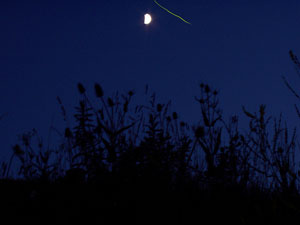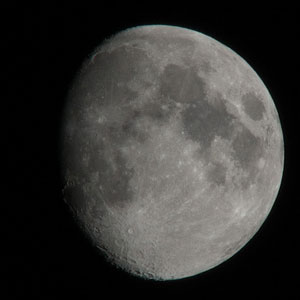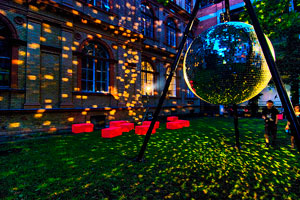
No Torch Required
Long, long ago in a city far, far away, I was a novice gardener with very limited horticultural knowledge (yes, I know it’s hard to believe). One phrase I kept hearing as a young pup was moon planting and, I’ll confess, it confused me. My grandmother spoke of and practiced moon planting religiously, and this mystified me for one main reason – my grandmother refused to leave the confines of her lounge room after dark, for fear of being mobbed by cane toads. How then could she possibly garden by the moon?
As I and my horticultural knowledge grew, I realised that moon planting had nothing to do with gardening after dark, rather gardening by the phases of the moon. Quite frankly, it was easier for me to get my head around gardening by torchlight than it was to understand the principles of moon planting. But, like any good gardener, I persevered and, while I don’t profess to be an expert in the field of moon planting, I now have a far greater understanding of this long used and passionately practiced permaculture principle. So, for your enjoyment, I present the “Beginners Guide to Moon Planting” and no, you won’t need a torch!
I’m Being Followed by a Moon Shadow

Moon planting is old… really old! Older than my car, my favourite jeans, even my nanna – we are talking ancient! In fact, the moon planting system has been utilised by just about every early culture in the world and its popularity and relevance has not diminished over time. Moon planting has seen a resurgence of sorts over the last 40 years, thanks in no small part to the popularity of permaculture, and there are some valid reasons for this. It is said that by planting, cultivating, harvesting, weeding and the like in the appropriate moon phase, the flavour, yield, and vigour of your edible crops can be significantly increased, without the addition of fertilisers. This is a top outcome – for your wallet, your taste buds, your health and the health of the planet! But, what’s it all about, does it really work, how do we do it and how on earth do we decipher those moon planting charts?
We know, just from sitting at the beach and watching the tide, that the moon has an impact and affect on the earth, but what does this have to do with gardening? Well, if you’re into moon planting, a fair bit. The Synodic Cycle (the moon or lunar cycle) not only controls the tide, but is also reported to have a serious influence on the surface tension of liquids, and, in turn, plant growth. Scientific studies have shown that subtle changes to the biological functions of plants occur in direct correlation to the planets tidal changes, due to alterations to the Earths electromagnetic fields. Yeah, it’s all a bit complex, but think about it this way – the moon has an impact on water movement on earth, plants take up water from the soil through their roots, while seeds require a fair whack of the wet stuff to germinate. It makes sense then, that the phase of the moon would impact upon the way plants take up water and in turn, the way plants germinate and grow!

So, how can we use this knowledge, and the moon, to our advantage in the garden? Simply by knowing the phases of the moon (relax, there are only four main ones) and what they represent, we can begin to plan our moon gardening calendar. The moon moves through a complete cycle every 29 and a bit days, and, during that time, we have four main moon “quarters”:
New Moon Phase
When: From New Moon (crescent moon or dark moon) to the first quarter moon
What Happens: The moon is waxing (growing bigger) in this phase, and living things apparently feel an upsurge of energy! One thing is for sure though, sap rises during this period. Delay doing anything in the patch until a tiny wee fingernail of the moon is actually visible.
What to do in the patch: Planting, grafting and transplanting leafy annuals is recommended in this phase, as is whacking in cereal and grain crops. It’s a great time to mow the lawn, prune many plants and provide low environmental impact liquid fertiliser to the patch.
First Quarter Phase
When: From First Quarter to Second Quarter
What Happens: The moon is still waxing (growing bigger) in this phase, and the sap is still flowing! Gardening is NOT recommended in the 12 hours before the full moon.
What to do in the patch: Still a great phase for starting things off and even better for planting, grafting and transplanting fruiting annuals (those that produce above the ground, and have their seeds inside, like tomatoes, capsicums, beans and peas). Cereals and grains can also go in now, and it’s still okay to feed if you need.
Full Moon Phase
When: From 12 hours after Full Moon to Third Quarter
What Happens: All living things, be it plants, pets or people, are at the peak of their electromagnetic energy during the full moon phase (we’ve all heard about folks getting the crazies around this time, it’s all about the energy!).
What to do in the patch: Sap is flowing downwards during this time, so whacking in bulbs and root crops that produce underground is perfect. Pruning and harvesting is recommended during this phase, but avoid planting most foliage and edible plants, as their initial growth will be impressive but will wane (just like the moon during this phase)

Last Quarter Phase
When: From Third Quarter to New Moon (dark moon)
What Happens: This phase is barren which, in gardening terms, can be translated as, well, a bit boring and tedious.
What to do in the patch: This phase is all about doing those annoying jobs in the garden, the ones we put off all the time, like weeding, cultivating, pest control and fertilising. It’s also the best time to mow the lawn, especially if you want to slow down the growth of the grass. Preparing patches for impending planting is a perfect project during this phase.
So, now that you are armed with all this information, I can hear you ask “does this moon planting caper actually work?”. Well, to be honest, I don’t have an answer. Many of my colleagues swear by it, while others (like myself) tend to garden when we have time, irrespective of the phase the moon is in. There is loads of evidence available from both schools of thought, and, at a recent garden show I attended, moon planting calendars were selling like hotcakes. Speaking of calendars.
Whatever way you look at it, moon planting is illuminating, with or without a head torch! Happy gardening all you stars!
Related Articles:
Garden Journaling – Slow down to tune in.
As we move through the year and our gardens evolve, there's something magical about documenting the journey. Garden journaling is an art that enables…
The Importance of building soil health for a biodeverse, productive garden
Creating a thriving garden that not only sustains itself but also contributes to the broader ecosystem requires more than just sunlight and water.…



